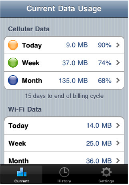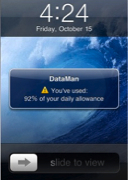When the iPhone was introduced in June 2007, AT&T’s 2-year contract required a data plan—there was no cell-only option. But the pricing of $30 a month for unlimited data was groundbreaking. The carrier killed the unlimited option exactly three years later. Existing agreements are honored as long as you don’t let them lapse, but all new users have to choose between a 200MB/month ($15/month) or 2GB/month data plan ($25/month). Going over your data limit is not cheap: $15 for an additional 200MB or $10 for 1GB, depending on your plan.
New iPhone users need to watch their data usage. Dial *3282# and AT&T will send you an SMS with your data usage and the date of your next bill cycle. In addition, AT&T’s myWireless Mobile app (free, app2.me/2538) lets you check your usage. Unfortunately, both methods rely on the user remembering to check. Fortunately, there’s DataMan.


DataMan helps monitor your data usage over time and alerts you as you approach and go over user-defined thresholds.
$0.99, DataMan
DataMan by X-Vision monitors both your cell and Wi-Fi usage and notifies you when you have passed one of four user-configurable thresholds. DataMan’s three views are accessed via the icons at the bottom of the screen. The Settings screen is where you set your bill date, daily allowances, and the four Alert Thresholds. The Current screen shows your Cellular and Wi-Fi Data usage for the day, week, and month. Choose a time period in the History screen and you are presented with your past usage by location. A Google Map is displayed with usage data points to show you where you used a data connection and how much data you used.
DataMan helps monitor your data usage over time and alerts you as you approach and go over user-defined thresholds.
The most important use of DataMan is to avoid incurring onerous overage charges. In addition, you can use the app to monitor your usage over time to see if you can safely switch to a cheaper plan. The $10 difference in AT&T’s two plans is not that significant, but DataMan works with all carriers. Some international carriers are not only expensive they don’t offer the ability to track data usage. The app can be very useful in those markets. Currently, the app only works with the iPhone and iPod touch (Wi-Fi only monitoring with the latter.)
Because the app runs in the background it requires iOS 4. DataMan won’t work some older iPhone models. I tried to install it on the iPad but couldn’t because it “requires a newer version of iPad software.” Fortunately, the developer plans to release an updated version of the program to support the iPad when it gets the iOS 4.2 update sometime in November. Hopefully, the updated app will work with Verizon’s recently announced iPad as well. It would certainly be useful on the 3G versions of the iPad.
Some users have complained that DataMan drains their battery because it runs in the background and uses location services. The developer claims that location services are only checked when cell towers are changed and that the app uses a “low power option”. I did not notice any significant decrease in battery life. There is no way to turn this feature off in the current version, but you will be able to in the next version of the app.
Although the application is called “DataMan” on the iTunes Store and in iTunes, the current version appears as “Data Usage” when loaded on your device. DataMan has some oddities and limitations which the developer promises to fix in a future version.

